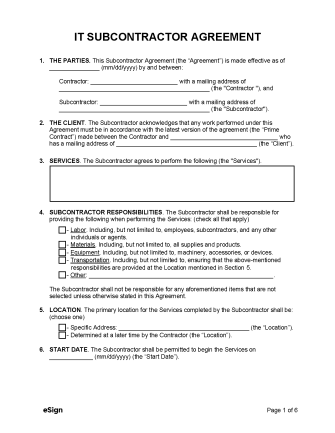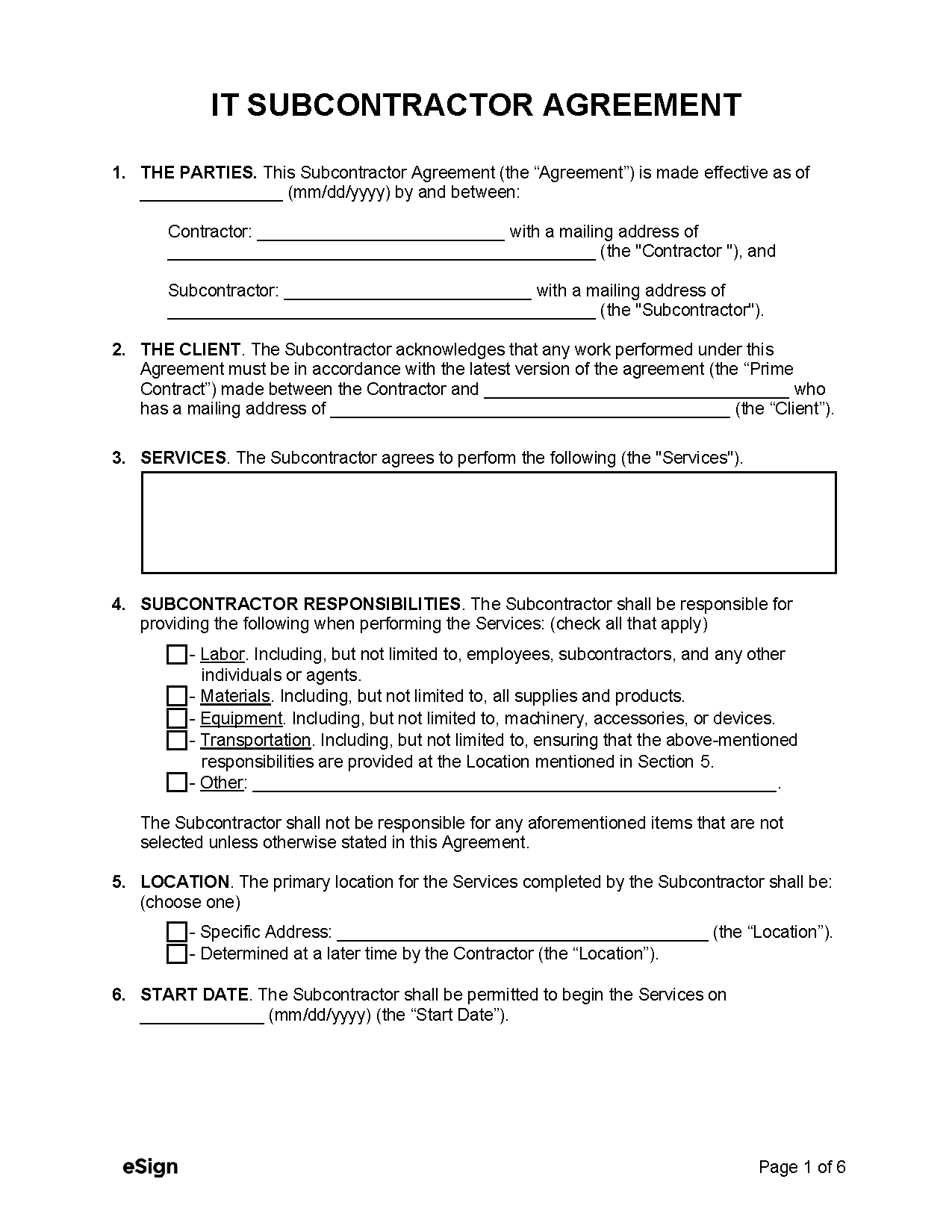Common Uses
A prime contractor may need to hire an IT subcontractor to speed up a project or when a specialist is needed to complete a portion of the project. Some examples of IT subcontracted jobs are:
- Web developer
- Software developer
- Cybersecurity analyst
- Network administrator
- Database administrator
What’s Included
Information technology subcontractor agreements will generally include the following:
- The Parties (Identification) – The client, contractor, and subcontractor names and mailing addresses.
- Services – A description of the tasks the subcontractor will carry out.
- Responsibilities – Whether the subcontractor will be responsible for providing labor, materials, equipment, and transportation.
- Cost (Fees) – The subcontractor’s compensation and payment schedule.
- Term – The date on which the subcontractor may begin their work and the deadline for completion.
- Subcontracting – Specifies whether the subcontractor may hire additional subcontractors.
- Insurance – States whether the subcontractor must purchase liability insurance and, if so, the minimum amount.
- Resolution of disputes – Establishes how disputes will be resolved (e.g., mediation, arbitration, etc.).
- Signatures – The signatures, printed names, and signing dates of the parties.
Sample
Download: PDF, Word (.docx), OpenDocument
IT SUBCONTRACTOR AGREEMENT
This Information Technology (IT) Agreement (the “Agreement”) is made between:
Contractor: [CONTRACTOR NAME] with a mailing address of [CONTRACTOR ADDRESS] (the “Contractor”), AND
Subcontractor (IT Professional): [SUBCONTRACTOR NAME] with a mailing address of [SUBCONTRACTOR ADDRESS] (the “Subcontractor”).
WHEREAS, the Contractor intends to pay the Subcontractor for Services provided, effective [MM/DD/YYYY] (the “Effective Date”), under the following terms and conditions:
1. THE CLIENT. The Subcontractor acknowledges that any services performed under this Agreement must be in accordance with the latest version of the agreement (the “Prime Contract”) made between the Contractor and [CLIENT NAME], who has a mailing address of [CLIENT MAILING ADDRESS] (the “Client”).
2. IT SERVICES. The Subcontractor agrees to perform the following IT services: [DESCRIBE IT SERVICES] (the “Services”).
3. SUBCONTRACTOR RESPONSIBILITIES. The Subcontractor shall be responsible for providing the following materials and equipment, with any unlisted item a responsibility of the Contractor: [LIST MATERIALS AND/OR EQUIPMENT THE SUBCONTRACTOR WILL PROVIDE].
4. LOCATION. The primary location for the Services completed by the Subcontractor shall be [PRIMARY LOCATION ADDRESS] (the “Location”).
5. TERM. The Subcontractor shall be permitted to begin the Services on [MM/DD/YYYY] (the “Start Date”). Unless otherwise stated, the Subcontractor will be required to complete the Services in a reasonable period in accordance with industry standards.
6. PAYMENT. The Contractor shall pay the Subcontractor $[AMOUNT] per [PAYMENT BASIS (E.G., HOUR)] for the Services. Payment shall be made by [PAYMENT METHOD] every [PAYMENT FREQUENCY].
7. TERMINATION. During the course of this Agreement, either party can terminate this agreement by providing [#] days’ notice to the other.
8. INDEMNIFICATION. The Subcontractor shall indemnify and hold the Contractor and Client harmless from any loss or liability from performing the Services under this Agreement.
9. GOVERNING LAW. This Agreement shall be governed under the laws in the State of [STATE].
10. ADDITIONAL PROVISIONS.
[ADD ANY ADDITIONAL PROVISIONS HERE (OPTIONAL)].
IN WITNESS WHEREOF, this Agreement was signed by the parties under the hands of their duly authorized officers and made effective as of the undersigned date.
Contractor Signature: _____________________ Date: [MM/DD/YYYY]
Print Name: [CONTRACTOR NAME]
Subcontractor’s Signature: _____________________ Date: [MM/DD/YYYY]
Print Name: [SUBCONTRACTOR NAME]

